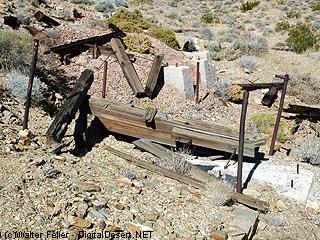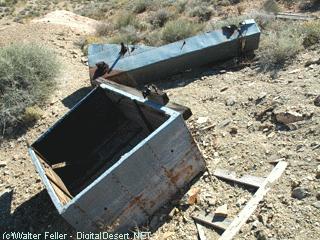Chloride Cliff
Chloride Cliff is a term which has been applied to a geographic area, a series of mines, a town, and a mining district. For the purposes of this discussion, Chloride Cliff will be used in its geographic sense, to define an area four miles square. This area starts at the Cliff itself on the south, where one may stand on an old mine dump and gaze down upon a spectacular view of Death Valley some 5,000 feet below, if the wind does not blow you off the side of the cliff. From here, the mining area stretches northwest beyond the site of Chloride City, with old mines and dumps covering the ridges and shallow valleys along the way.
The oldest mine on the east side of Death Valley National Monument, and one of the oldest within the entire Monument, is the original Chloride Cliff Mine. It was discovered on August 14th, 1871, by A. J. Franklin, a civil engineer employed by the U.S. Government to assist in surveying the Nevada-California state line. Although the story varies--some say he picked up a rock to kill a rattlesnake and found ore--Franklin somehow found what he thought was a vein of chloride of silver. He immediately staked out seven claims, called the Franklin Group, and the following October formed the Chloride Cliff Mining Company.
In April of 1872, Franklin returned to his locations and began to work. Crude on-site tests indicated that his silver ore was worth between $200 and $1,000 per ton, and he began to dig a shaft. By July of 1873, when Franklin was employing seven miners, the shaft had been sunk to seventy feet, and he had nearly 100 tons of ore on the dump, ready for shipment. Transportation, however, was a definite problem, for there were as yet no distinct roads connecting Death Valley with any point of civilization. The mine was dependent upon San Bernardino, 180 miles away, for food and supplies, and although one man set a record for riding the distance in fifty-six hours, the normal string of pack mules took considerably longer to cover the route.
During 1872 and 1873, when the Chloride Cliff Mine was operating, pack trains arrived with supplies about every three months. As these mule teams traveled back and forth, they slowly identified the best route between Death Valley and San Bernardino, and by 1873, Franklin was proudly able to boast that a fully laden wagon could travel to within three hundred feet of his mine. This early route into the heart of Death Valley was subsequently used during the first years of borax mining at the Harmony and Eagle borax works.
But even with a new road to follow, the great expenses of packing in supplies and hauling out ore made the Chloride Cliff Mine unprofitable, unless a cheaper method of reducing the ore could be found. A newspaper reporter who visited the mine in 1873 summed up the situation facing Franklin. "in many things the prospects seem favorable, they have unquestionably struck a vast amount of ore but as yet the ledge is not sufficiently prospected to justify a great expenditure of capital in erecting works . . ." And while Franklin was trying to make up his mind, the great Panamint boom started on the west side of Death Valley, which made his small mine relatively unattractive to those who had capital to invest. After nearly two years of operation, the Chloride Cliff Mine shut down.
Next >
Historic Resource Study
A History of Mining
Linda Greene - NPS


